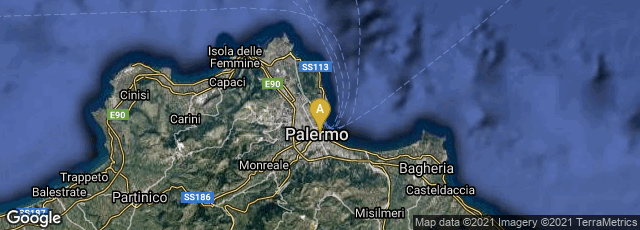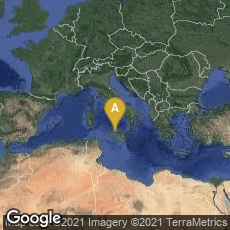A section of Al-Idrisi's world map from 'Alî ibn Hasan al-Hûfî al-Qâsimî's 1456 copy. According to the Bibliothèque nationale de France, Ten copies of the Kitab Rujar or Tabula Rogeriana exist today. Of these, six contain at the start of the work a circular map of the world which is not mentioned in the text of al-Idris. Note that south is at the top of the map.


Modern considation, done in 1929 of the Tabula Rogeriana, drawn by al-Idrisi for Roger II of Sicily in 1154. The consolidation was created from al-Idrisi's 70 double-page spreads. It is shown upside-down as the original had South at the top.
Of the ten surviving manuscript copies of the Kitab Rudjdjar (literally "The book of Roger" in Arabic) or Tabula Rogeriana, the earliest surviving copy, preserved in the Bibliothèque nationale de France (MS Arabe 2221), has been dated to about 1300. It is copy of a world map drawn in 1154 by the Arab geographer, Abu Abd Allah Muhammad al-Idrisi al-Qurtubi al-Hasani al-Sabti, or simply El Idrisi, or Muhammad al-Idrisi.
"Al-Idrisi worked on the accompanying commentaries and illustrations of the map for eighteen years at the court of the Norman King Roger II of Sicily in Palermo. The map, written in Arabic, shows the Eurasian continent in its entirety, but only shows the northern part of the African continent. The map is actually oriented with the North at the bottom. It remained the most accurate world map for the next three centuries.
"Roger II of Sicily had his world map drawn on a circle of silver weighing about 400 pounds. The works of Al-Idrisi include Nozhat al-mushtaq fi ikhtiraq al-afaq - a compendium of the geographic and sociological knowledge of his time as well as descriptions of his own travels illustrated with over seventy maps; Kharitat al-`alam al-ma`mour min al-ard (Map of the inhabited regions of the earth) wherein he divided the world into 7 regions, the first extending from the equator to 23 degrees latitude, and the seventh being from 54 to 63 degrees followed by a region uninhabitable due to cold and snow.
On the work of al-Idrisi, S. P. Scott commented:
"The compilation of Edrisi marks an era in the history of science. Not only is its historical information most interesting and valuable, but its descriptions of many parts of the earth are still authoritative. For three centuries geographers copied his maps without alteration. The relative position of the lakes which form the Nile, as delineated in his work, does not differ greatly from that established by Baker and Stanley more than seven hundred years afterwards, and their number is the same. The mechanical genius of the author was not inferior to his erudition. The celestial and terrestrial planisphere of silver which he constructed for his royal patron was nearly six feet in diameter, and weighed four hundred and fifty pounds; upon the one side the zodiac and the constellations, upon the other-divided for convenience into segments-the bodies of land and water, with the respective situations of the various countries, were engraved" (Wikipedia article on Muhammad al-Idrisi, accessed 01-12-2009).